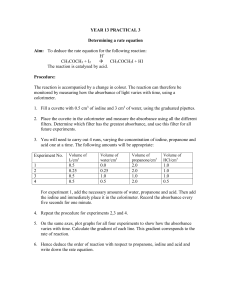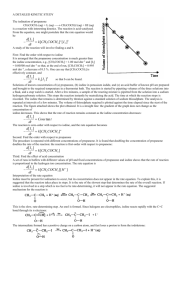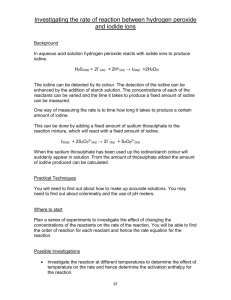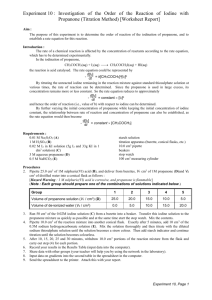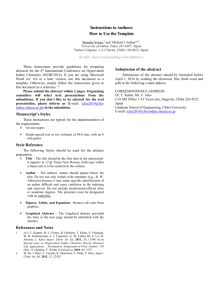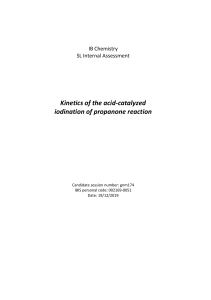Investigating the rate of reaction between iodine and propanone
advertisement
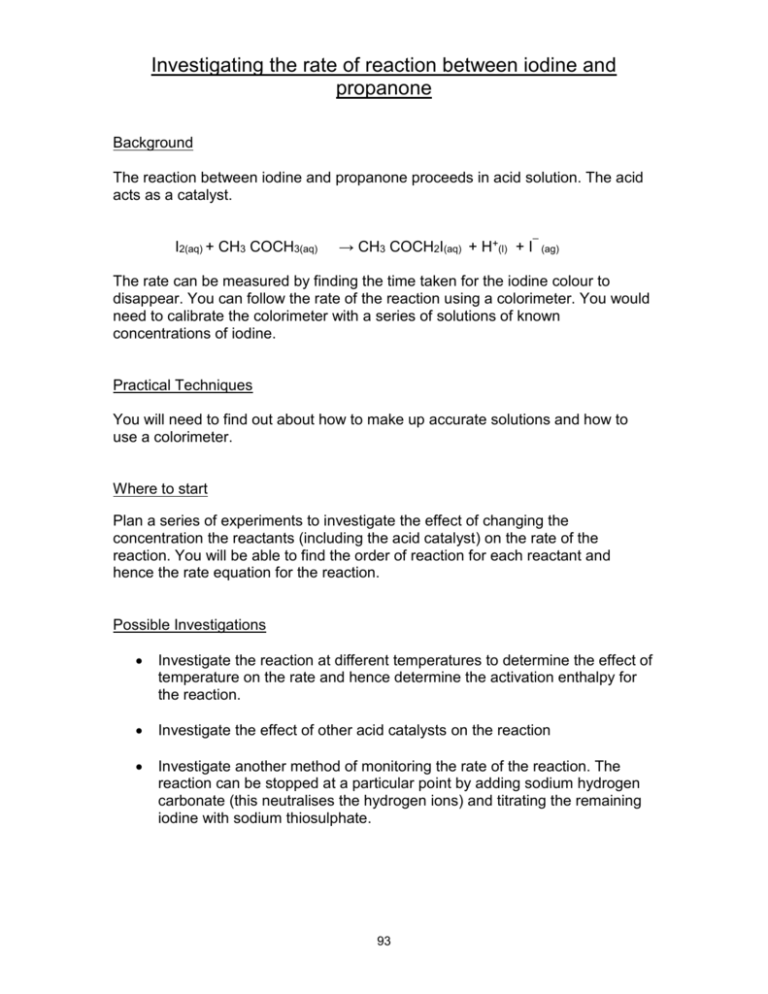
Investigating the rate of reaction between iodine and propanone Background The reaction between iodine and propanone proceeds in acid solution. The acid acts as a catalyst. I2(aq) + CH3 COCH3(aq) → CH3 COCH2I(aq) + H+(l) + I¯ (ag) The rate can be measured by finding the time taken for the iodine colour to disappear. You can follow the rate of the reaction using a colorimeter. You would need to calibrate the colorimeter with a series of solutions of known concentrations of iodine. Practical Techniques You will need to find out about how to make up accurate solutions and how to use a colorimeter. Where to start Plan a series of experiments to investigate the effect of changing the concentration the reactants (including the acid catalyst) on the rate of the reaction. You will be able to find the order of reaction for each reactant and hence the rate equation for the reaction. Possible Investigations Investigate the reaction at different temperatures to determine the effect of temperature on the rate and hence determine the activation enthalpy for the reaction. Investigate the effect of other acid catalysts on the reaction Investigate another method of monitoring the rate of the reaction. The reaction can be stopped at a particular point by adding sodium hydrogen carbonate (this neutralises the hydrogen ions) and titrating the remaining iodine with sodium thiosulphate. 93 Sources of Information Thorpe A., Colorimetry, Chemistry Review, February 2003 The Chemistry Video Consortium and The Royal Society of Chemistry (2000) Practical Chemistry for Schools and Colleges CD ROM Thorpe A, Making a standard solution, Chemistry Review, November 2002 Hill G. C. and Holman J., (2001), Chemistry in Context Laboratory Manual (Fifth Edition), Nelson Thornes Lainchbury A, Stephens J, Thompson A, (1997), Advanced Practical Chemistry, John Murray http://users.erols.com/merosen/kinetics.htm Thorpe A., Assessing the risks in practical work, Chemistry Review, September 2000 Thorpe A., Experimental error and error analysis: just how good are those results, Chemistry Review, November 2001 TurnerJ.W., The kinetics and mechanism of alkaline hydrolysis, School Science Review, September 1971, Vol 53, No182, p.127 Brown G.R.and Matthews P.S.C., The propanone –iodopropanone equilibrium, School Science Review, December 1988, Vol 70, No251, p..115 Tetlow K.S. and Justin R., An introduction to chemical colorimetry and photometric methods for schools, School Science Review, March 1970, Vol 51, No176, p.555 Miller P.J., Acid-base titration curves from a clock reaction, School Science Review, June 1973, Vol 54, No189, p.758 94 Teachers' Notes General This investigation is based around an experiment that can be found in many practical chemistry books. The practical techniques are fairly straightforward and students of all abilities should be able to carry out the experiments successfully. Students will need to learn how to calibrate and use a colorimeter. Please note that preparing an iodine solution can be time consuming and it may be advisable to ask the technician to prepare it in advance or purchase a ready made solution. It may be necessary to standardise the solution if the iodine does not completely dissolve. Note that students will be limited to changing the concentration of iodine only if they use the titration method suggested. Chemical Principles Reaction Kinetics, organic reactions, halogens. Essential Equipment Burettes, pipettes, colorimeter Essential Chemicals Iodine, potassium iodide, propanone, sulphuric acid, Safety No risk assessment has been given. It is essential that students prepare a detailed risk assessment before they start. Teachers must be satisfied that this is suitable for the proposed investigation. 95 Starter Experiment - Investigating the rate of reaction between iodine and propanone Here is a suggested method to investigate the effect of varying the concentration of propanone. Prepare the following solutions Iodine (in potassium iodide solution) 0.02 mol dm-3 Sulphuric acid 1 mol dm-3 propanone 1 mol dm-3 You will need to think about how much of each solution to prepare. This will depend on how much of each solution is used in each experiment and how many experiments you do (including any repeats). Use pipettes and /or burettes to prepare the following mixtures. As soon as you have added the propanone you must immediately transfer a portion of the solution to the colorimeter and begin to follow the reaction. Expt iodine (cm3) 1 2 3 4 5 8 8 8 8 8 Sulphuric acid (cm3) 2 2 2 2 2 Water (cm3) propanone (cm3) 8 2 6 4 4 6 2 8 0 10 You need to record the readings at regular time intervals until the reaction has finished or until you have enough readings to draw a suitable graph. 96
